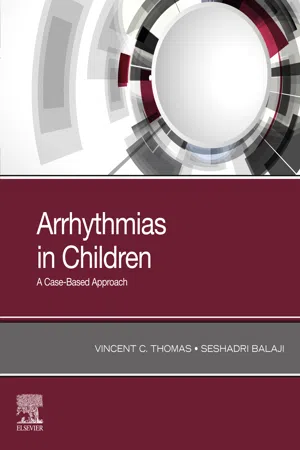
- 180 pages
- English
- ePUB (mobile friendly)
- Available on iOS & Android
About this book
Pediatric arrhythmias present numerous challenges to pediatric cardiologists and other practitioners who see pediatric patients, including pediatricians, family physicians, emergency physicians, residents, fellows, and other clinicians. Arrhythmias in Children: A Case-Based Approach features practical methods for diagnosing and treating arrhythmias in these patients across all settings. Nearly three dozen real-world scenarios are presented, followed by a discussion of the diagnosis, clinical thinking process involved, treatment options, expected outcomes, and how to manage anticipated and unanticipated outcomes. These practical, realistic cases provide a unique and engaging way of approaching these challenging patient scenarios.- Uses a case-based approach for a full spectrum of pediatric arrythmias in the newborn, child, pre-teen, and teenager.- Presents history and physical, differential diagnoses, tests to order, and practical plans of action.- Includes a section on arrythmias in special circumstances.- Models clinical thinking skills for a wide number of real-world patient situations.- Reviews pertinent clinical guidelines, treatment, and follow up.
Frequently asked questions
- Essential is ideal for learners and professionals who enjoy exploring a wide range of subjects. Access the Essential Library with 800,000+ trusted titles and best-sellers across business, personal growth, and the humanities. Includes unlimited reading time and Standard Read Aloud voice.
- Complete: Perfect for advanced learners and researchers needing full, unrestricted access. Unlock 1.4M+ books across hundreds of subjects, including academic and specialized titles. The Complete Plan also includes advanced features like Premium Read Aloud and Research Assistant.
Please note we cannot support devices running on iOS 13 and Android 7 or earlier. Learn more about using the app.
Information
Chapter 1: Newborn nursery infant that has bradycardia
Abstract
Keywords
Case
What am I thinking?
| Differential diagnosis |
|---|
| Likely |
| Sinus bradycardia ⁃ Secondary to respiratory pauses or apnea ⁃ Secondary to maternally administered medications |
| Possible |
Blocked premature atrial contractions Sinus bradycardia secondary to induced hypothermia |
| Rare |
Congenital hypothyroidism (sinus bradycardia) Congenital heart block Long QT syndrome (sinus bradycardia, 2:1 atrioventricular block) Sick sinus syndrome or heterotaxy syndrome (left atrial isomerism) secondary to congenital heart disease |
History and physical

Diagnostic testing


Action plan
Table of contents
- Cover image
- Title page
- Table of Contents
- Copyright
- Preface
- Acknowledgments
- Section 1. Infant
- Section 2. Child
- Section 3. Adolescent
- Section 4. Special circumstances
- Index